Financial Accounting Report: Analysis of ANZ and Westpac Banks
VerifiedAdded on 2020/03/23
|20
|1321
|243
Report
AI Summary
This financial accounting report analyzes the annual reports of ANZ and Westpac banks, focusing on the effectiveness of communication and information disclosure. The report, written from an investor's perspective, evaluates areas for improvement in financial reporting, including segmental analysis, disclosure of credit and liquidity risks, and adherence to Basel regulations. It compares the two banks' practices, highlighting differences in segmental analysis and the presentation of Basel information. The report recommends improvements in line with IASB principles, emphasizing the need for entity-specific information, proper formatting, and the use of graphical representations to aid investor decision-making. The author suggests that effective communication is crucial for investors to make informed financial decisions and recommends that organizations incorporate forward-looking information and quantitative targets. The report concludes with specific recommendations for enhancing the clarity and usefulness of financial reports, advocating for a more standardized and investor-focused approach.
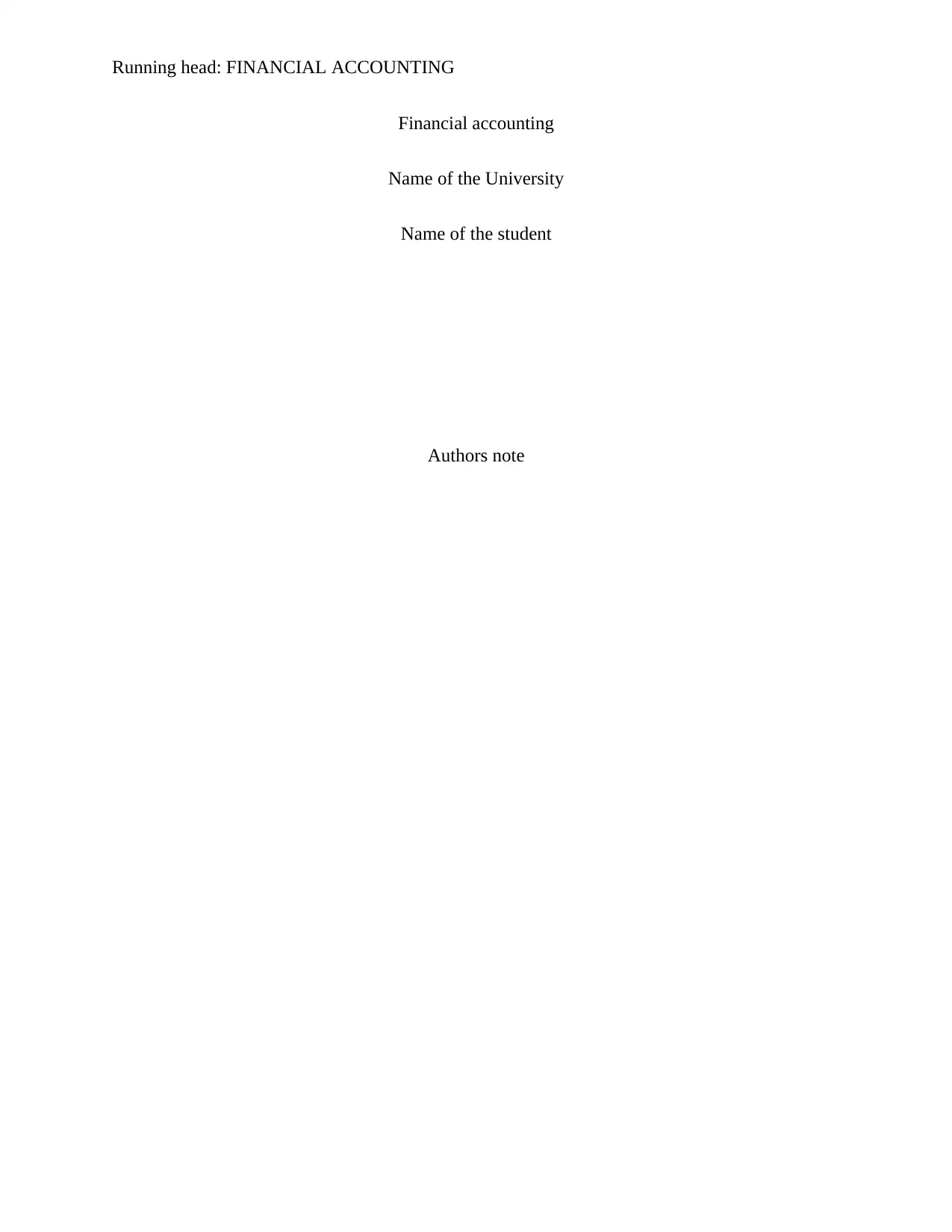
Running head: FINANCIAL ACCOUNTING
Financial accounting
Name of the University
Name of the student
Authors note
Financial accounting
Name of the University
Name of the student
Authors note
Paraphrase This Document
Need a fresh take? Get an instant paraphrase of this document with our AI Paraphraser
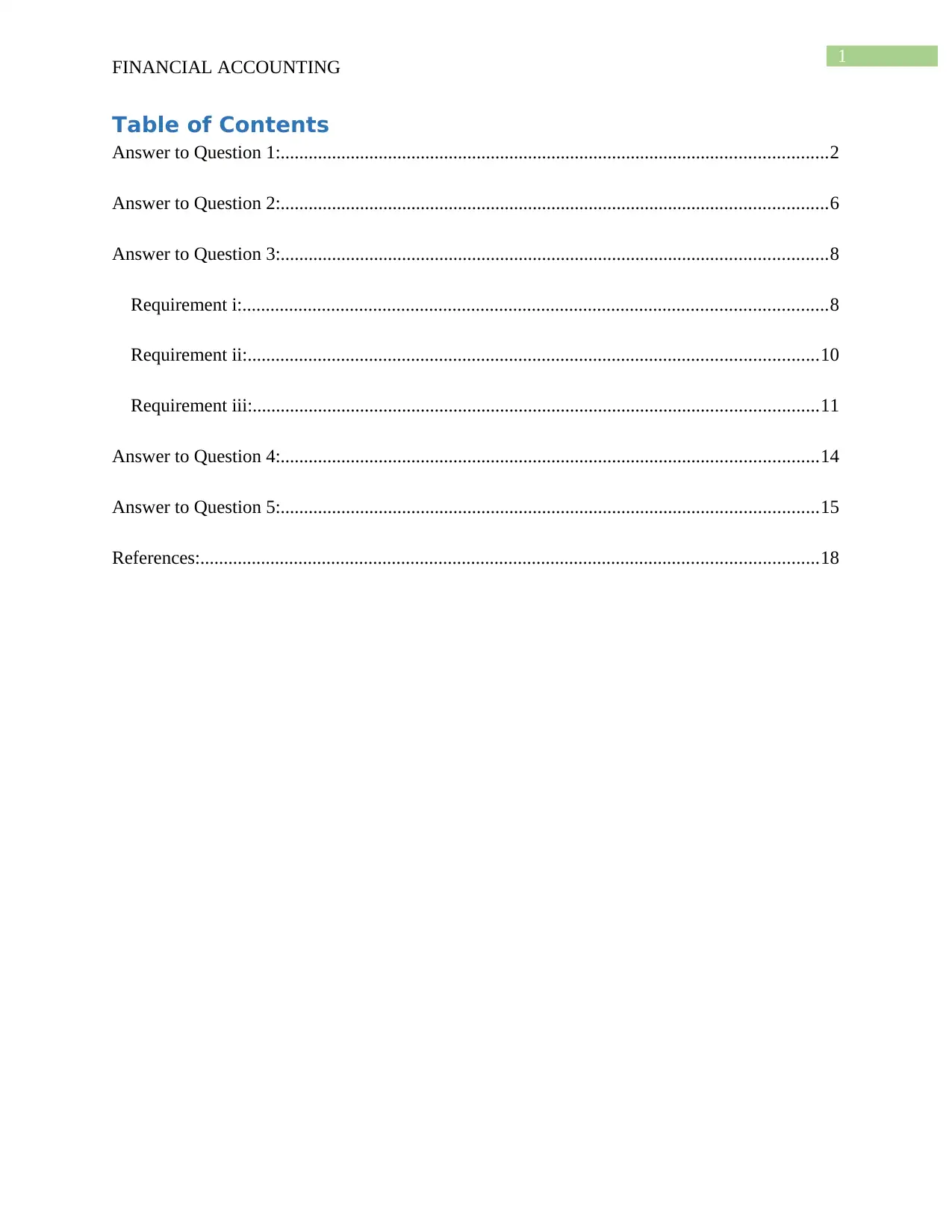
1
FINANCIAL ACCOUNTING
Table of Contents
Answer to Question 1:.....................................................................................................................2
Answer to Question 2:.....................................................................................................................6
Answer to Question 3:.....................................................................................................................8
Requirement i:.............................................................................................................................8
Requirement ii:..........................................................................................................................10
Requirement iii:.........................................................................................................................11
Answer to Question 4:...................................................................................................................14
Answer to Question 5:...................................................................................................................15
References:....................................................................................................................................18
FINANCIAL ACCOUNTING
Table of Contents
Answer to Question 1:.....................................................................................................................2
Answer to Question 2:.....................................................................................................................6
Answer to Question 3:.....................................................................................................................8
Requirement i:.............................................................................................................................8
Requirement ii:..........................................................................................................................10
Requirement iii:.........................................................................................................................11
Answer to Question 4:...................................................................................................................14
Answer to Question 5:...................................................................................................................15
References:....................................................................................................................................18
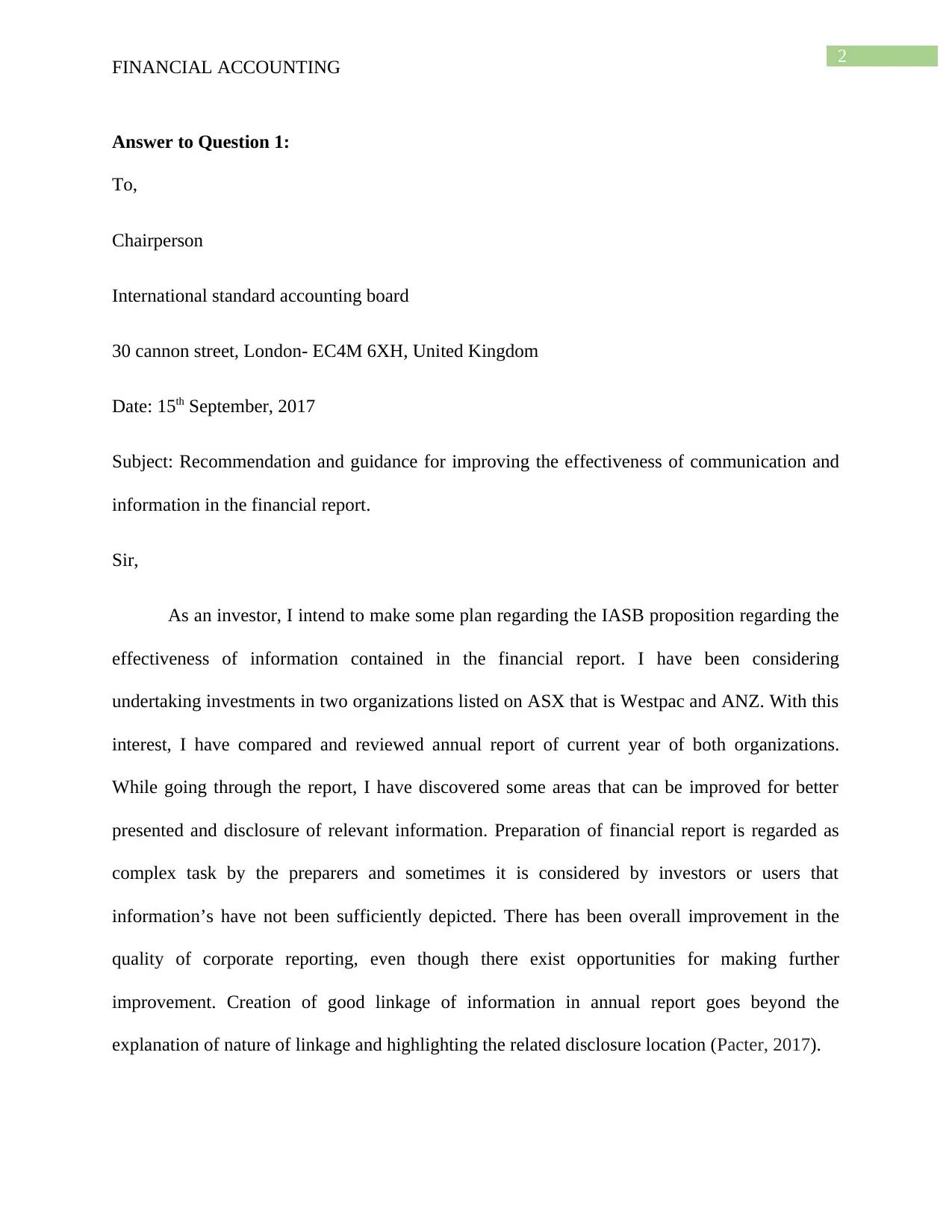
2
FINANCIAL ACCOUNTING
Answer to Question 1:
To,
Chairperson
International standard accounting board
30 cannon street, London- EC4M 6XH, United Kingdom
Date: 15th September, 2017
Subject: Recommendation and guidance for improving the effectiveness of communication and
information in the financial report.
Sir,
As an investor, I intend to make some plan regarding the IASB proposition regarding the
effectiveness of information contained in the financial report. I have been considering
undertaking investments in two organizations listed on ASX that is Westpac and ANZ. With this
interest, I have compared and reviewed annual report of current year of both organizations.
While going through the report, I have discovered some areas that can be improved for better
presented and disclosure of relevant information. Preparation of financial report is regarded as
complex task by the preparers and sometimes it is considered by investors or users that
information’s have not been sufficiently depicted. There has been overall improvement in the
quality of corporate reporting, even though there exist opportunities for making further
improvement. Creation of good linkage of information in annual report goes beyond the
explanation of nature of linkage and highlighting the related disclosure location (Pacter, 2017).
FINANCIAL ACCOUNTING
Answer to Question 1:
To,
Chairperson
International standard accounting board
30 cannon street, London- EC4M 6XH, United Kingdom
Date: 15th September, 2017
Subject: Recommendation and guidance for improving the effectiveness of communication and
information in the financial report.
Sir,
As an investor, I intend to make some plan regarding the IASB proposition regarding the
effectiveness of information contained in the financial report. I have been considering
undertaking investments in two organizations listed on ASX that is Westpac and ANZ. With this
interest, I have compared and reviewed annual report of current year of both organizations.
While going through the report, I have discovered some areas that can be improved for better
presented and disclosure of relevant information. Preparation of financial report is regarded as
complex task by the preparers and sometimes it is considered by investors or users that
information’s have not been sufficiently depicted. There has been overall improvement in the
quality of corporate reporting, even though there exist opportunities for making further
improvement. Creation of good linkage of information in annual report goes beyond the
explanation of nature of linkage and highlighting the related disclosure location (Pacter, 2017).
⊘ This is a preview!⊘
Do you want full access?
Subscribe today to unlock all pages.

Trusted by 1+ million students worldwide
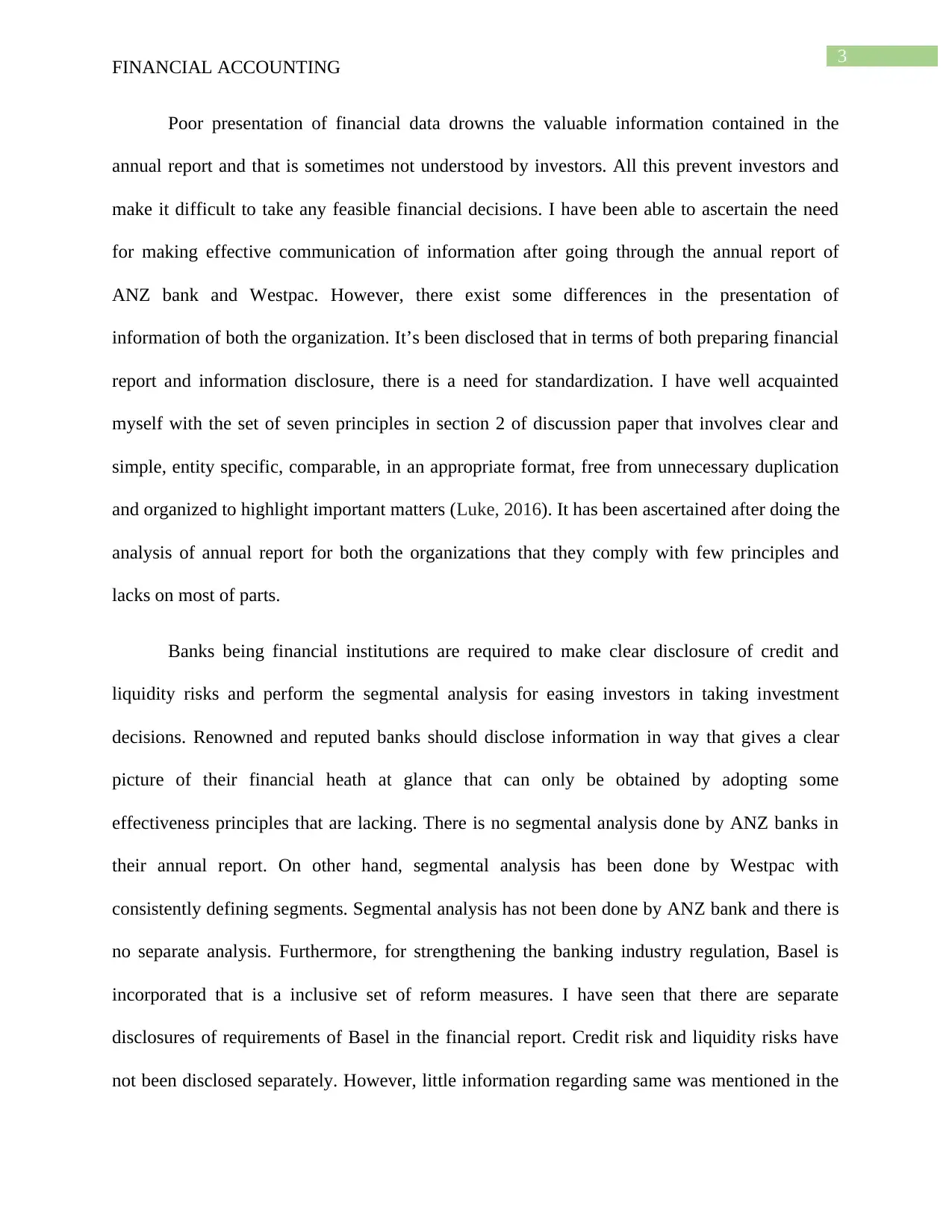
3
FINANCIAL ACCOUNTING
Poor presentation of financial data drowns the valuable information contained in the
annual report and that is sometimes not understood by investors. All this prevent investors and
make it difficult to take any feasible financial decisions. I have been able to ascertain the need
for making effective communication of information after going through the annual report of
ANZ bank and Westpac. However, there exist some differences in the presentation of
information of both the organization. It’s been disclosed that in terms of both preparing financial
report and information disclosure, there is a need for standardization. I have well acquainted
myself with the set of seven principles in section 2 of discussion paper that involves clear and
simple, entity specific, comparable, in an appropriate format, free from unnecessary duplication
and organized to highlight important matters (Luke, 2016). It has been ascertained after doing the
analysis of annual report for both the organizations that they comply with few principles and
lacks on most of parts.
Banks being financial institutions are required to make clear disclosure of credit and
liquidity risks and perform the segmental analysis for easing investors in taking investment
decisions. Renowned and reputed banks should disclose information in way that gives a clear
picture of their financial heath at glance that can only be obtained by adopting some
effectiveness principles that are lacking. There is no segmental analysis done by ANZ banks in
their annual report. On other hand, segmental analysis has been done by Westpac with
consistently defining segments. Segmental analysis has not been done by ANZ bank and there is
no separate analysis. Furthermore, for strengthening the banking industry regulation, Basel is
incorporated that is a inclusive set of reform measures. I have seen that there are separate
disclosures of requirements of Basel in the financial report. Credit risk and liquidity risks have
not been disclosed separately. However, little information regarding same was mentioned in the
FINANCIAL ACCOUNTING
Poor presentation of financial data drowns the valuable information contained in the
annual report and that is sometimes not understood by investors. All this prevent investors and
make it difficult to take any feasible financial decisions. I have been able to ascertain the need
for making effective communication of information after going through the annual report of
ANZ bank and Westpac. However, there exist some differences in the presentation of
information of both the organization. It’s been disclosed that in terms of both preparing financial
report and information disclosure, there is a need for standardization. I have well acquainted
myself with the set of seven principles in section 2 of discussion paper that involves clear and
simple, entity specific, comparable, in an appropriate format, free from unnecessary duplication
and organized to highlight important matters (Luke, 2016). It has been ascertained after doing the
analysis of annual report for both the organizations that they comply with few principles and
lacks on most of parts.
Banks being financial institutions are required to make clear disclosure of credit and
liquidity risks and perform the segmental analysis for easing investors in taking investment
decisions. Renowned and reputed banks should disclose information in way that gives a clear
picture of their financial heath at glance that can only be obtained by adopting some
effectiveness principles that are lacking. There is no segmental analysis done by ANZ banks in
their annual report. On other hand, segmental analysis has been done by Westpac with
consistently defining segments. Segmental analysis has not been done by ANZ bank and there is
no separate analysis. Furthermore, for strengthening the banking industry regulation, Basel is
incorporated that is a inclusive set of reform measures. I have seen that there are separate
disclosures of requirements of Basel in the financial report. Credit risk and liquidity risks have
not been disclosed separately. However, little information regarding same was mentioned in the
Paraphrase This Document
Need a fresh take? Get an instant paraphrase of this document with our AI Paraphraser
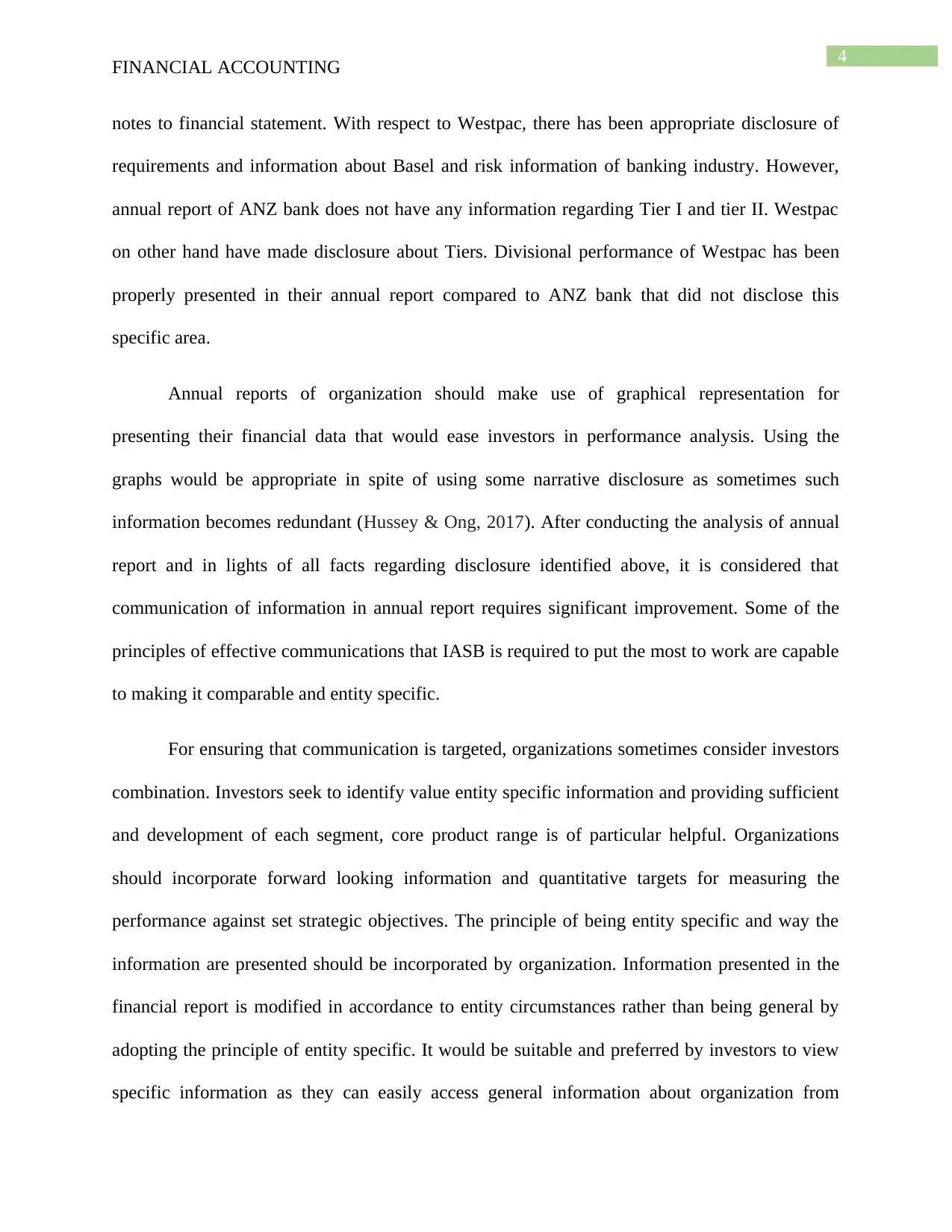
4
FINANCIAL ACCOUNTING
notes to financial statement. With respect to Westpac, there has been appropriate disclosure of
requirements and information about Basel and risk information of banking industry. However,
annual report of ANZ bank does not have any information regarding Tier I and tier II. Westpac
on other hand have made disclosure about Tiers. Divisional performance of Westpac has been
properly presented in their annual report compared to ANZ bank that did not disclose this
specific area.
Annual reports of organization should make use of graphical representation for
presenting their financial data that would ease investors in performance analysis. Using the
graphs would be appropriate in spite of using some narrative disclosure as sometimes such
information becomes redundant (Hussey & Ong, 2017). After conducting the analysis of annual
report and in lights of all facts regarding disclosure identified above, it is considered that
communication of information in annual report requires significant improvement. Some of the
principles of effective communications that IASB is required to put the most to work are capable
to making it comparable and entity specific.
For ensuring that communication is targeted, organizations sometimes consider investors
combination. Investors seek to identify value entity specific information and providing sufficient
and development of each segment, core product range is of particular helpful. Organizations
should incorporate forward looking information and quantitative targets for measuring the
performance against set strategic objectives. The principle of being entity specific and way the
information are presented should be incorporated by organization. Information presented in the
financial report is modified in accordance to entity circumstances rather than being general by
adopting the principle of entity specific. It would be suitable and preferred by investors to view
specific information as they can easily access general information about organization from
FINANCIAL ACCOUNTING
notes to financial statement. With respect to Westpac, there has been appropriate disclosure of
requirements and information about Basel and risk information of banking industry. However,
annual report of ANZ bank does not have any information regarding Tier I and tier II. Westpac
on other hand have made disclosure about Tiers. Divisional performance of Westpac has been
properly presented in their annual report compared to ANZ bank that did not disclose this
specific area.
Annual reports of organization should make use of graphical representation for
presenting their financial data that would ease investors in performance analysis. Using the
graphs would be appropriate in spite of using some narrative disclosure as sometimes such
information becomes redundant (Hussey & Ong, 2017). After conducting the analysis of annual
report and in lights of all facts regarding disclosure identified above, it is considered that
communication of information in annual report requires significant improvement. Some of the
principles of effective communications that IASB is required to put the most to work are capable
to making it comparable and entity specific.
For ensuring that communication is targeted, organizations sometimes consider investors
combination. Investors seek to identify value entity specific information and providing sufficient
and development of each segment, core product range is of particular helpful. Organizations
should incorporate forward looking information and quantitative targets for measuring the
performance against set strategic objectives. The principle of being entity specific and way the
information are presented should be incorporated by organization. Information presented in the
financial report is modified in accordance to entity circumstances rather than being general by
adopting the principle of entity specific. It would be suitable and preferred by investors to view
specific information as they can easily access general information about organization from
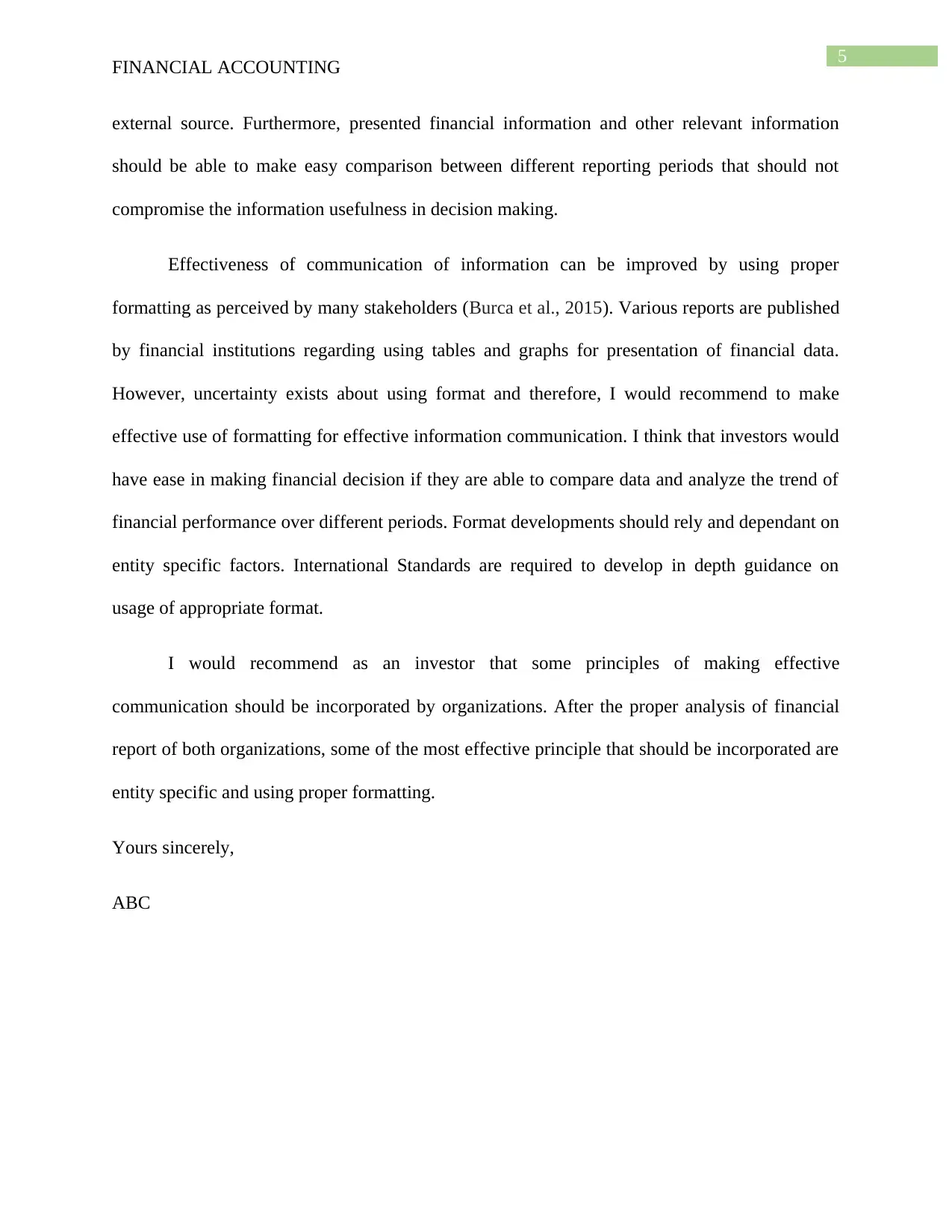
5
FINANCIAL ACCOUNTING
external source. Furthermore, presented financial information and other relevant information
should be able to make easy comparison between different reporting periods that should not
compromise the information usefulness in decision making.
Effectiveness of communication of information can be improved by using proper
formatting as perceived by many stakeholders (Burca et al., 2015). Various reports are published
by financial institutions regarding using tables and graphs for presentation of financial data.
However, uncertainty exists about using format and therefore, I would recommend to make
effective use of formatting for effective information communication. I think that investors would
have ease in making financial decision if they are able to compare data and analyze the trend of
financial performance over different periods. Format developments should rely and dependant on
entity specific factors. International Standards are required to develop in depth guidance on
usage of appropriate format.
I would recommend as an investor that some principles of making effective
communication should be incorporated by organizations. After the proper analysis of financial
report of both organizations, some of the most effective principle that should be incorporated are
entity specific and using proper formatting.
Yours sincerely,
ABC
FINANCIAL ACCOUNTING
external source. Furthermore, presented financial information and other relevant information
should be able to make easy comparison between different reporting periods that should not
compromise the information usefulness in decision making.
Effectiveness of communication of information can be improved by using proper
formatting as perceived by many stakeholders (Burca et al., 2015). Various reports are published
by financial institutions regarding using tables and graphs for presentation of financial data.
However, uncertainty exists about using format and therefore, I would recommend to make
effective use of formatting for effective information communication. I think that investors would
have ease in making financial decision if they are able to compare data and analyze the trend of
financial performance over different periods. Format developments should rely and dependant on
entity specific factors. International Standards are required to develop in depth guidance on
usage of appropriate format.
I would recommend as an investor that some principles of making effective
communication should be incorporated by organizations. After the proper analysis of financial
report of both organizations, some of the most effective principle that should be incorporated are
entity specific and using proper formatting.
Yours sincerely,
ABC
⊘ This is a preview!⊘
Do you want full access?
Subscribe today to unlock all pages.

Trusted by 1+ million students worldwide
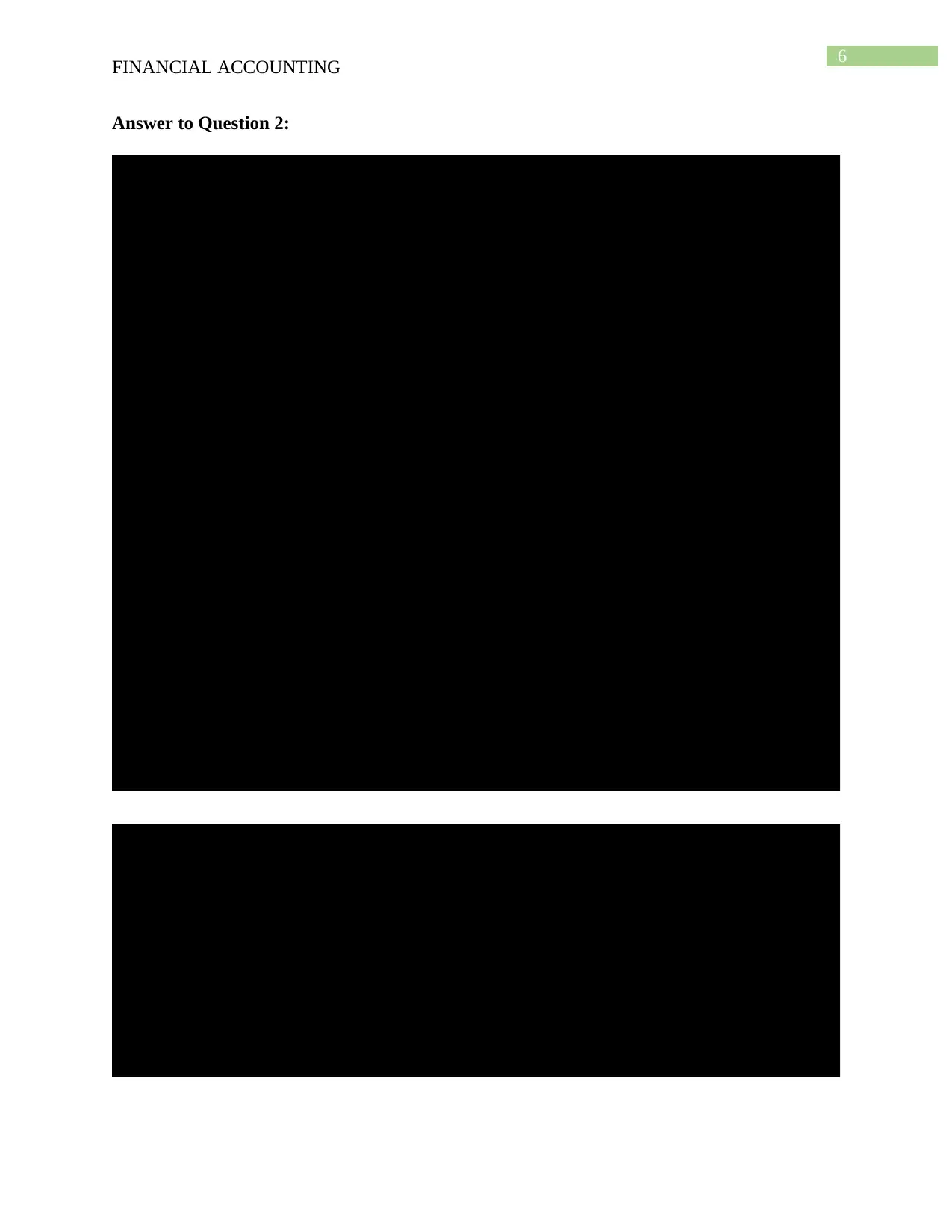
6
FINANCIAL ACCOUNTING
Answer to Question 2:
Dr. Cr.
Date Amount Amount
31/03/2017 Bank A/c. Dr. $8,200,000
To.
Preference Share Application A/c. $1,600,000
To. Ordinary Share Application A/c. $6,600,000
15/4/2017
Preference Share Application
A/c. Dr. $1,600,000
To. Preference Share Capital A/c. $1,600,000
Ordinary Share Application
A/c. Dr. $6,600,000
To. Ordinary Share Capital A/c. $6,000,000
To. Ordinary Share Allotment A/c. $600,000
Ordinary Share Allotment A/c. Dr. $3,000,000
To. Ordinary Share Capital A/c. $3,000,000
In the books of Harriette Ltd.
Journal Entries
Particulars
(Being application money received for 2,000,000 ordinary shares
and 1,000,000 preference shares)
(Being application money received for pf. Shares transferred to Pf.
Share capital)
(Being application money received for ordinary share capital
transferred to ordinary share capital and excess amount adjusted
with due allotment)
(Being allotment money due on alloted shares)
15/5/2017 Bank A/c. Dr. $2,400,000
To. Ordinary Share Allotment A/c. $2,400,000
1/8/2017 Ordinary Share Call A/c. Dr. $1,000,000
To. Ordinary Share Capital A/c. $1,000,000
1/9/2017 Bank A/c. Dr. $975,000
Calls-in-Arrear A/c. Dr. $25,000
To. Ordinary Share Call A/c. $1,000,000
(Being due allotment money received)
(Being call money due on alloted shares)
(Being due call money received except for 50000 shares)
FINANCIAL ACCOUNTING
Answer to Question 2:
Dr. Cr.
Date Amount Amount
31/03/2017 Bank A/c. Dr. $8,200,000
To.
Preference Share Application A/c. $1,600,000
To. Ordinary Share Application A/c. $6,600,000
15/4/2017
Preference Share Application
A/c. Dr. $1,600,000
To. Preference Share Capital A/c. $1,600,000
Ordinary Share Application
A/c. Dr. $6,600,000
To. Ordinary Share Capital A/c. $6,000,000
To. Ordinary Share Allotment A/c. $600,000
Ordinary Share Allotment A/c. Dr. $3,000,000
To. Ordinary Share Capital A/c. $3,000,000
In the books of Harriette Ltd.
Journal Entries
Particulars
(Being application money received for 2,000,000 ordinary shares
and 1,000,000 preference shares)
(Being application money received for pf. Shares transferred to Pf.
Share capital)
(Being application money received for ordinary share capital
transferred to ordinary share capital and excess amount adjusted
with due allotment)
(Being allotment money due on alloted shares)
15/5/2017 Bank A/c. Dr. $2,400,000
To. Ordinary Share Allotment A/c. $2,400,000
1/8/2017 Ordinary Share Call A/c. Dr. $1,000,000
To. Ordinary Share Capital A/c. $1,000,000
1/9/2017 Bank A/c. Dr. $975,000
Calls-in-Arrear A/c. Dr. $25,000
To. Ordinary Share Call A/c. $1,000,000
(Being due allotment money received)
(Being call money due on alloted shares)
(Being due call money received except for 50000 shares)
Paraphrase This Document
Need a fresh take? Get an instant paraphrase of this document with our AI Paraphraser
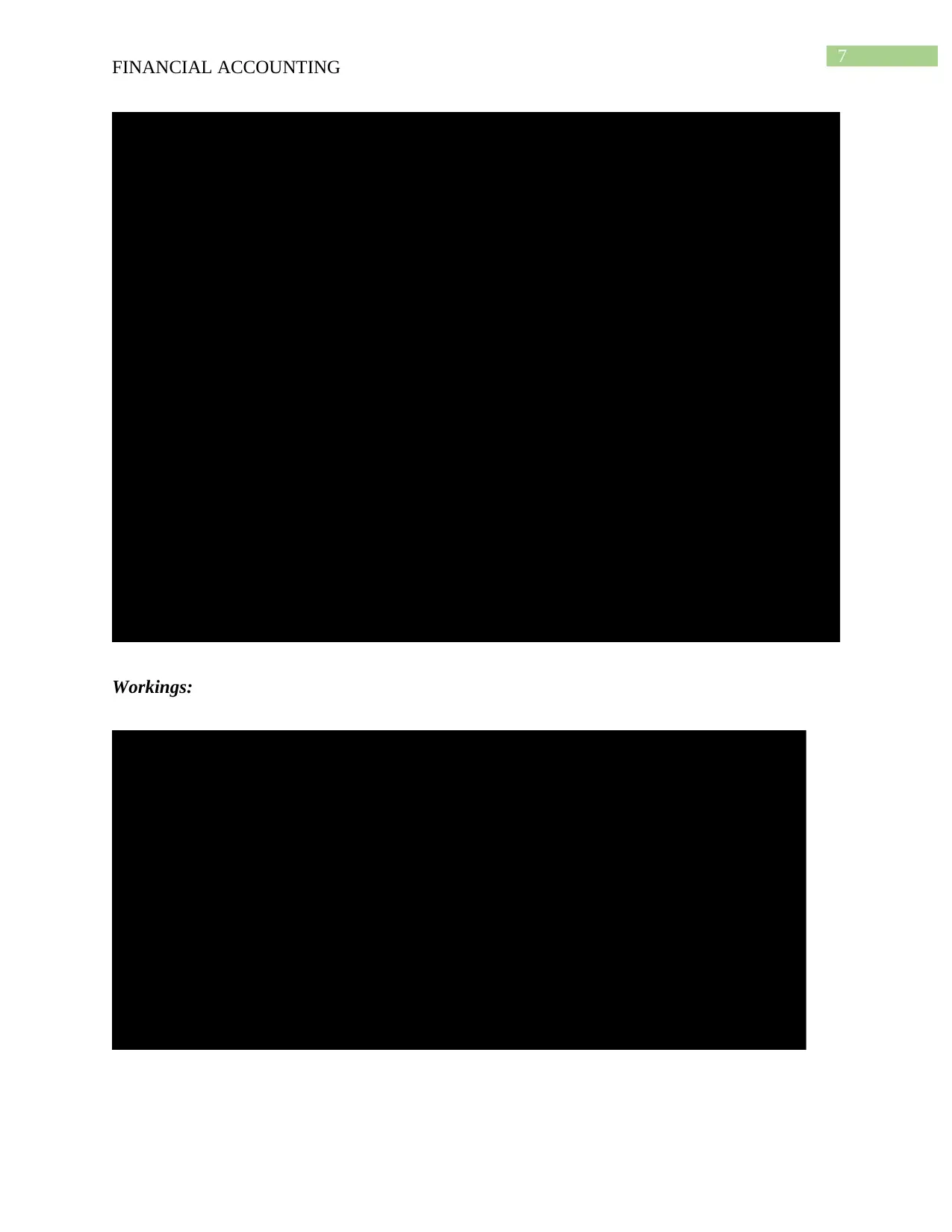
7
FINANCIAL ACCOUNTING
15/9/2017 Ordinary Share Capital A/c. Dr. $250,000
To. Calls-in-Arrear A/c. $25,000
To. Ordinary Share Forfeiture A/c. $225,000
Bank A/c. Dr. $210,000
Ordinary Share Forfeiture A/c. Dr. $40,000
To. Ordinary Share Capital A/c. $250,000
Cost of Forfeiture & Reissue
A/c. Dr. $7,500
To. Bank A/c. $7,500
Ordinary Share Forfeiture A/c. Dr. $185,000
To.
Cost of Forfeiture & Reissue A/c. $7,500
To. Capital Reserve A/c. $177,500
(Being the balance of share forfeiture a/c. after adjusting with cost
of forfeiture and reissue transferred to capital reserve)
(Being the 50000 shares, for which call money is due, forfeited
accordingly)
(Being the forfeited shares reissued for $4.20 per shares)
(Being cost of forfeiture and reissue of shares paid)
Workings:
Particulars Nos. Of Shares Value per Share Amount
Pf. Share Application Received A 800000 $2 $1,600,000
Ordinary Share Application Received B 2200000 $3 $6,600,000
Ordinary Share Application Alloted C 2000000 $3 $6,000,000
Ordinary Share Application Adjsuted D=B-C 200000 $3 $600,000
Ordinary Share Allotment Due E 2000000 $1.50 $3,000,000
Ordinary Share Allotment Received F=E-D 1800000 $2,400,000
Ordinary Share Call Due G 2000000 $0.50 $1,000,000
Ordinary Share Call Received H 1950000 $0.50 $975,000
FINANCIAL ACCOUNTING
15/9/2017 Ordinary Share Capital A/c. Dr. $250,000
To. Calls-in-Arrear A/c. $25,000
To. Ordinary Share Forfeiture A/c. $225,000
Bank A/c. Dr. $210,000
Ordinary Share Forfeiture A/c. Dr. $40,000
To. Ordinary Share Capital A/c. $250,000
Cost of Forfeiture & Reissue
A/c. Dr. $7,500
To. Bank A/c. $7,500
Ordinary Share Forfeiture A/c. Dr. $185,000
To.
Cost of Forfeiture & Reissue A/c. $7,500
To. Capital Reserve A/c. $177,500
(Being the balance of share forfeiture a/c. after adjusting with cost
of forfeiture and reissue transferred to capital reserve)
(Being the 50000 shares, for which call money is due, forfeited
accordingly)
(Being the forfeited shares reissued for $4.20 per shares)
(Being cost of forfeiture and reissue of shares paid)
Workings:
Particulars Nos. Of Shares Value per Share Amount
Pf. Share Application Received A 800000 $2 $1,600,000
Ordinary Share Application Received B 2200000 $3 $6,600,000
Ordinary Share Application Alloted C 2000000 $3 $6,000,000
Ordinary Share Application Adjsuted D=B-C 200000 $3 $600,000
Ordinary Share Allotment Due E 2000000 $1.50 $3,000,000
Ordinary Share Allotment Received F=E-D 1800000 $2,400,000
Ordinary Share Call Due G 2000000 $0.50 $1,000,000
Ordinary Share Call Received H 1950000 $0.50 $975,000
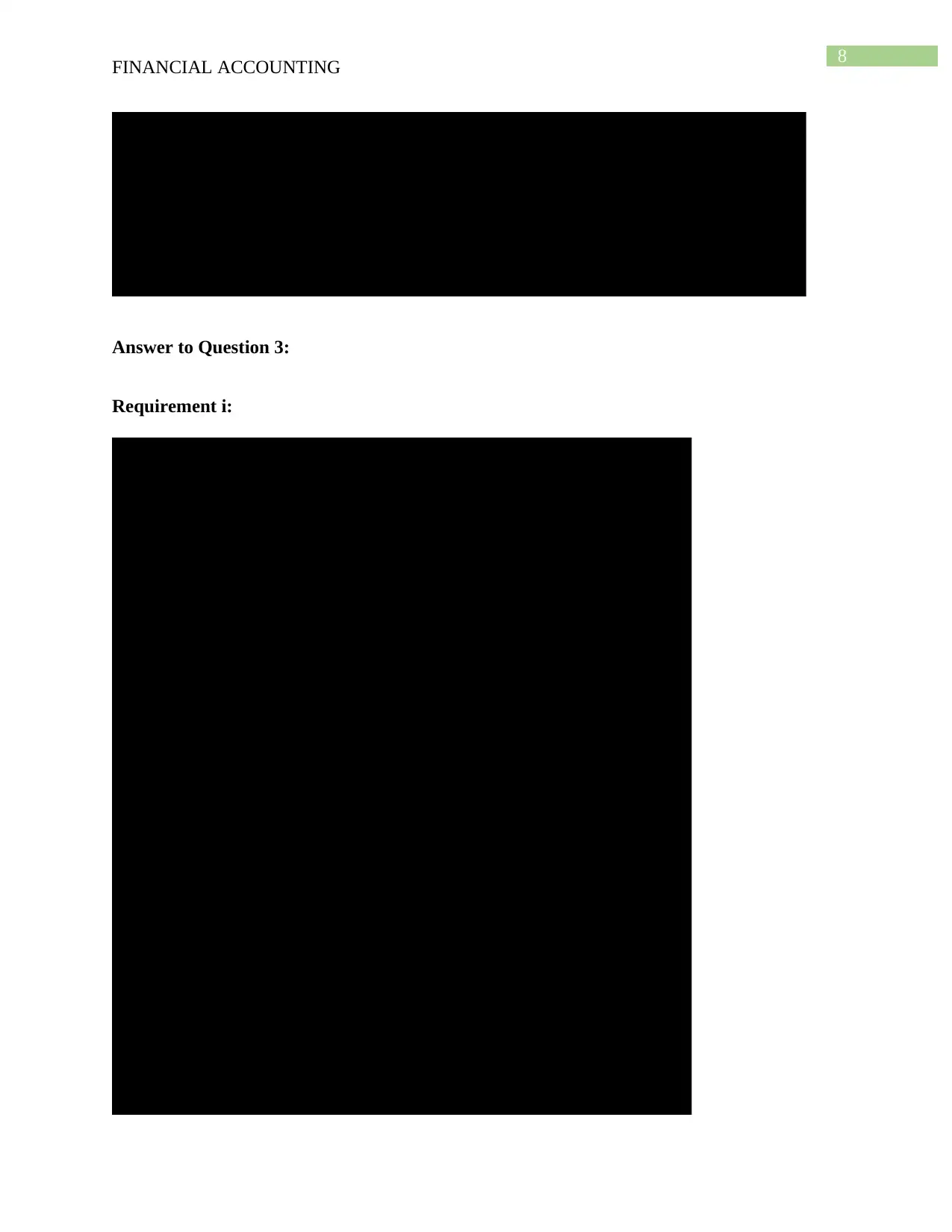
8
FINANCIAL ACCOUNTING
Calls-in-Arrear I 50000 $0.50 $25,000
Share Capital Forfeited J 50000 $5 $250,000
Share Forfeiture K=I-J 50000 $225,000
Share Capital received fro Reissue L 50000 $4.20 $210,000
Share forfeiture adusted with reissue M=J-L 50000 $40,000
Answer to Question 3:
Requirement i:
Particulars Amount Amount
Accounting profit before tax $66,000
Add:
Doubtful Debt Expense $5,000
Annual Leave $23,000
Warranty Expense $12,000
Depreciation Expense for accounting purpose $60,000
Insurance $40,000 $140,000
$206,000
Less:
Government Grant $20,000
Bad debt expense $1,000
Annual Leave Paid $3,000
Insurance Paid $50,000
Warranty Expense Paid $2,000
Depreciation Expense for Tax Purpose $50,000 $126,000
Taxable income $80,000
Tax on taxable income @30% $24,000
Less: 30% Tax paid on Sales Revenue $205,800
Income Tax Refundable ($181,800)
Worksheet for Curret Tax Liability/(Refundable):
FINANCIAL ACCOUNTING
Calls-in-Arrear I 50000 $0.50 $25,000
Share Capital Forfeited J 50000 $5 $250,000
Share Forfeiture K=I-J 50000 $225,000
Share Capital received fro Reissue L 50000 $4.20 $210,000
Share forfeiture adusted with reissue M=J-L 50000 $40,000
Answer to Question 3:
Requirement i:
Particulars Amount Amount
Accounting profit before tax $66,000
Add:
Doubtful Debt Expense $5,000
Annual Leave $23,000
Warranty Expense $12,000
Depreciation Expense for accounting purpose $60,000
Insurance $40,000 $140,000
$206,000
Less:
Government Grant $20,000
Bad debt expense $1,000
Annual Leave Paid $3,000
Insurance Paid $50,000
Warranty Expense Paid $2,000
Depreciation Expense for Tax Purpose $50,000 $126,000
Taxable income $80,000
Tax on taxable income @30% $24,000
Less: 30% Tax paid on Sales Revenue $205,800
Income Tax Refundable ($181,800)
Worksheet for Curret Tax Liability/(Refundable):
⊘ This is a preview!⊘
Do you want full access?
Subscribe today to unlock all pages.

Trusted by 1+ million students worldwide

9
FINANCIAL ACCOUNTING
Particulars Carrying Amount Tax Base Taxable
Temp’y Diffs
Deductible
Temp’y Diffs
$ $ $ $
Assets
Cash $10,000 $10,000
Trade Receivables $125,000 $125,000
Allowance for Doubtful Debts ($4,000) $0 $4,000
Inventories $60,000 $60,000
Prepaid Insurance $10,000 $10,000
Goodwill $20,000 $20,000
Equipment $300,000 $300,000
Accumulated Depreciation ($60,000) ($50,000) $10,000
Liabilities
Trade Payables $35,000 $35,000
Provision for Warranties $10,000 $10,000
Provision for Annual Leave $20,000 $20,000
Loan Payable $90,000 $90,000
Total Temporary differences $10,000 $44,000
Deferred tax liability (30%) $3,000
Deferred tax asset (30%) $13,200
Deferred Tax Worksheet:
FINANCIAL ACCOUNTING
Particulars Carrying Amount Tax Base Taxable
Temp’y Diffs
Deductible
Temp’y Diffs
$ $ $ $
Assets
Cash $10,000 $10,000
Trade Receivables $125,000 $125,000
Allowance for Doubtful Debts ($4,000) $0 $4,000
Inventories $60,000 $60,000
Prepaid Insurance $10,000 $10,000
Goodwill $20,000 $20,000
Equipment $300,000 $300,000
Accumulated Depreciation ($60,000) ($50,000) $10,000
Liabilities
Trade Payables $35,000 $35,000
Provision for Warranties $10,000 $10,000
Provision for Annual Leave $20,000 $20,000
Loan Payable $90,000 $90,000
Total Temporary differences $10,000 $44,000
Deferred tax liability (30%) $3,000
Deferred tax asset (30%) $13,200
Deferred Tax Worksheet:
Paraphrase This Document
Need a fresh take? Get an instant paraphrase of this document with our AI Paraphraser
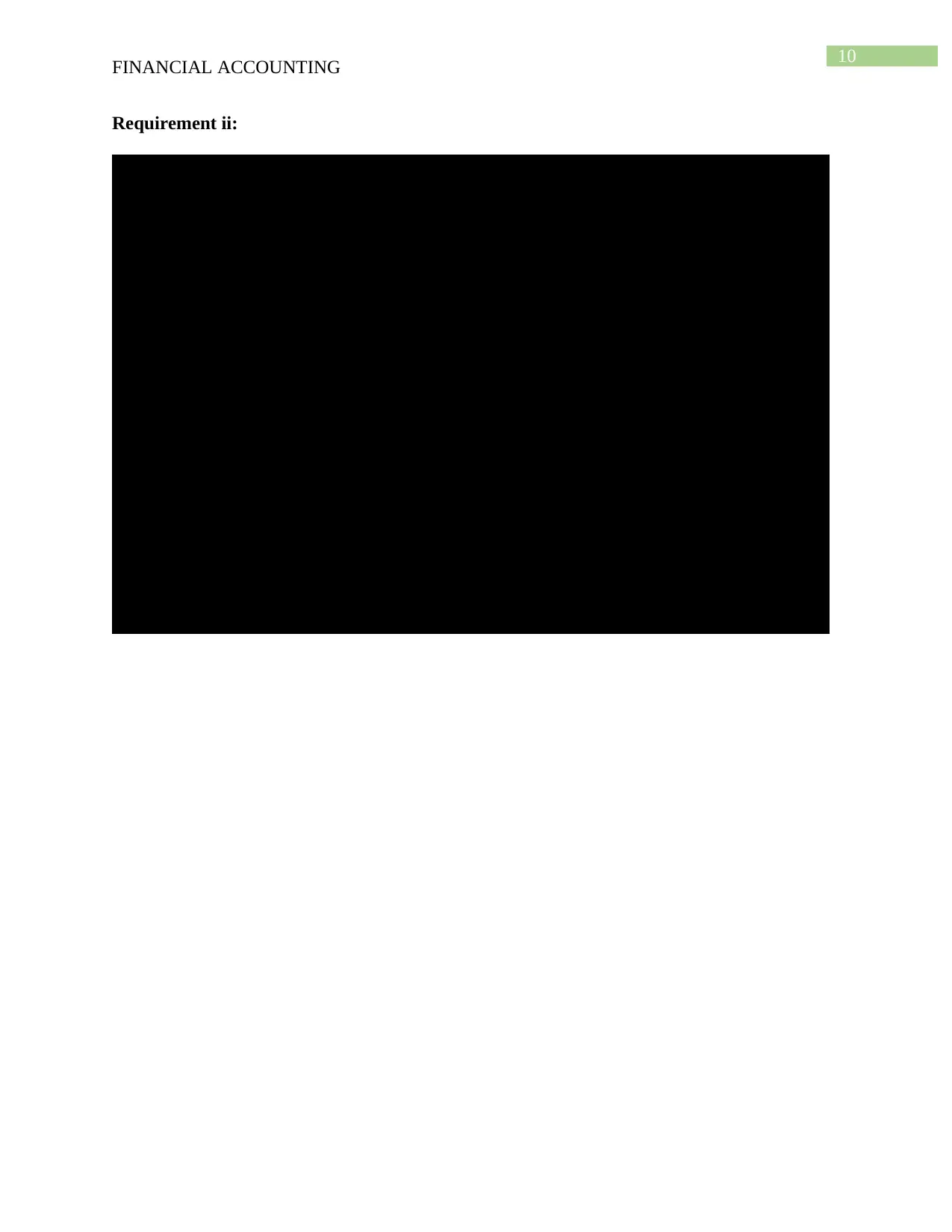
10
FINANCIAL ACCOUNTING
Requirement ii:
Dr. Cr.
Date Amount Amount
30/06/2017 Income Tax Expense A/c. Dr. $24,000
Income Tax Refundable A/c. Dr. $181,800
To, Advance Tax Paid A/c. $205,800
$13,200
Deferred Tax Assets A/c. Dr. $3,000
To, Deferred Tax Liability A/c. $10,200
To, Income Tax Expense A/c.
Profit & loss A/c. $21,000
To, Income Tax Expense A/c. $21,000
(Being deferred tax assets and deferred tax liabilities
recorded)
Particulars
(Being Income tax expenses adjusterd with advance tax paid
and income tax refundable recorded)
(Being income tax expense transferred to P/L A/c.)
FINANCIAL ACCOUNTING
Requirement ii:
Dr. Cr.
Date Amount Amount
30/06/2017 Income Tax Expense A/c. Dr. $24,000
Income Tax Refundable A/c. Dr. $181,800
To, Advance Tax Paid A/c. $205,800
$13,200
Deferred Tax Assets A/c. Dr. $3,000
To, Deferred Tax Liability A/c. $10,200
To, Income Tax Expense A/c.
Profit & loss A/c. $21,000
To, Income Tax Expense A/c. $21,000
(Being deferred tax assets and deferred tax liabilities
recorded)
Particulars
(Being Income tax expenses adjusterd with advance tax paid
and income tax refundable recorded)
(Being income tax expense transferred to P/L A/c.)

11
FINANCIAL ACCOUNTING
Requirement iii:
Particulars Amount Amount
Accounting profit before tax ($44,000)
Add:
Doubtful Debt Expense $5,000
Annual Leave $23,000
Warranty Expense $12,000
Depreciation Expense for accounting purpose $60,000
Insurance $40,000 $140,000
$96,000
Less:
Government Grant $20,000
Bad debt expense $1,000
Annual Leave Paid $3,000
Insurance Paid $50,000
Warranty Expense Paid $2,000
Depreciation Expense for Tax Purpose $50,000 $126,000
Taxable income ($30,000)
Tax on taxable income @30% $0
Less: 30% Tax paid on Sales Revenue $172,800
Income Tax Refundable ($172,800)
Worksheet for Curret Tax Liability/(Refundable):
FINANCIAL ACCOUNTING
Requirement iii:
Particulars Amount Amount
Accounting profit before tax ($44,000)
Add:
Doubtful Debt Expense $5,000
Annual Leave $23,000
Warranty Expense $12,000
Depreciation Expense for accounting purpose $60,000
Insurance $40,000 $140,000
$96,000
Less:
Government Grant $20,000
Bad debt expense $1,000
Annual Leave Paid $3,000
Insurance Paid $50,000
Warranty Expense Paid $2,000
Depreciation Expense for Tax Purpose $50,000 $126,000
Taxable income ($30,000)
Tax on taxable income @30% $0
Less: 30% Tax paid on Sales Revenue $172,800
Income Tax Refundable ($172,800)
Worksheet for Curret Tax Liability/(Refundable):
⊘ This is a preview!⊘
Do you want full access?
Subscribe today to unlock all pages.

Trusted by 1+ million students worldwide
1 out of 20
Related Documents
Your All-in-One AI-Powered Toolkit for Academic Success.
+13062052269
info@desklib.com
Available 24*7 on WhatsApp / Email
![[object Object]](/_next/static/media/star-bottom.7253800d.svg)
Unlock your academic potential
Copyright © 2020–2025 A2Z Services. All Rights Reserved. Developed and managed by ZUCOL.





